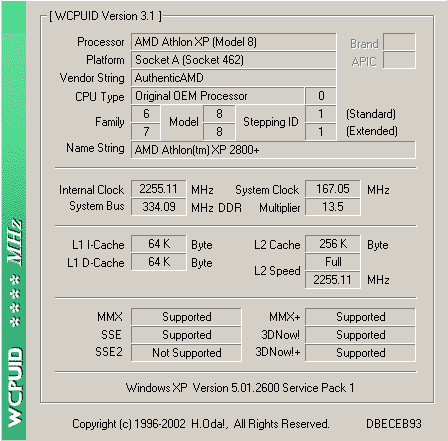AMD Travels Through Time: Athlon XP 2800+ with Dual-DDR
Details On The Athlon XP 2800+/2700+
The top model for January 2003: Athlon XP 2800+.
Details about the AMD Athlon XP 2800+.
After considerable discussions and simulations, AMD has finally made it: the FSB clock of 166 MHz has become reality. The chip manufacturer can now offer processors exclusively for the new clock speed, starting with the Athlon XP 2700+. Compared to its predecessor with 133 MHz FSB, the clock speed and bandwidth of the new processor are increased by almost 20%. This gives you 2.6 GB/s (166 MHz x 64 Bit x 2 flanks = 2.6 GB/s), as opposed to 2.1 GB/s.
| CPU core | Thoroughbred "B" | Thoroughbred "A" | Palomino |
|---|---|---|---|
| Wafer Surface | 31416 mm² | 31416 mm² | 31416 mm² |
| Die Surface | 84 mm² | 80 mm² | 128 mm² |
| Circuit Path Density | 0.13 µm | 0.13 µm | 0.18 µm |
| Waste (approx.) | 18% | 18% | 18% |
| Yield | 306 pieces/wafer | 322 pieces/wafer | 201 pieces/wafer |
Basically, the two new processors look like the other two CPUs with the Thoroughbred B core. The die surface is still 84 mm², ensuring effective heat transfer between CPU and cooler. For cost reasons, AMD does without a heat spreader. With a core voltage of 1.65 Volt and a clock speed of 2250 MHz (Athlon XP 2800+), the maximal thermal dissipation is 75.3 Watt, while that of the Athlon XP 2700+ (2166 MHz) is 68.3 Watt.
There's no change in the maximum temperature, which is still 85 degrees Celsius. The sample processor does reveal some special aspects, however: for all of the CPUs with the Thoroughbred B core (from Athlon XP 2400+ up to XP 2800+), the thermal diode doesn't work. This means that when there's a cooler defect, the motherboard will not be able to protect the CPU. A correct measurement of the die temperature is not possible.
| Intel | AMD | Availability |
|---|---|---|
| P4 3.33 GHz | Row 0 - Cell 1 | Row 0 - Cell 2 |
| Row 1 - Cell 0 | Row 1 - Cell 1 | Athlon XP 3000+ |
| P4 3.06 GHz (Hyperthr.) | Row 2 - Cell 1 | from November 2002 |
| Row 3 - Cell 0 | Athlon XP 2800+(41 days) | from January 2003 |
| P4 2.8 GHz(112 days) | Row 4 - Cell 1 | yes |
| Row 5 - Cell 0 | Athlon XP 2600+(72 days) | from October 2002 |
| Row 6 - Cell 0 | Athlon XP 2200+ (0.13 µm)(89 days) | yes |
| P4 2.53 GHz(34 days) | Row 7 - Cell 1 | yes |
| P4 2.4 GHz(85 days) | Row 8 - Cell 1 | yes |
| Row 9 - Cell 0 | Athlon XP 2100+(65 days) | yes |
| P4 2.2 GHz (0.13µm)(133 days) | Athlon XP 2000+(63 days) | yes |
| Row 11 - Cell 0 | Athlon XP 1900+(27 days) | yes |
| Row 12 - Cell 0 | Athlon XP 1800+(97 days) | yes |
| P4 2.0 GHz(89 days) | Row 13 - Cell 1 | production stopped |
| Row 14 - Cell 0 | Athlon 1400(104 days) | production stopped |
| P4 1.7 GHz(190 days) | Row 15 - Cell 1 | production stopped |
| Row 16 - Cell 0 | Athlon 1333(155 days) | production stopped |
| P4 1.5 GHz (0.18 µm) | Row 17 - Cell 1 | production stopped |
| Row 18 - Cell 0 | Athlon 1200(135 days) | production stopped |
| Row 19 - Cell 0 | Athlon 1000 (0.18 µm) | production stopped |
Get Tom's Hardware's best news and in-depth reviews, straight to your inbox.
Current page: Details On The Athlon XP 2800+/2700+
Prev Page The Future Is Now: The Athlon XP 2800+ Is Here! Next Page Comparison: Heat Dissipation Of All AMD Athlon CPUs
